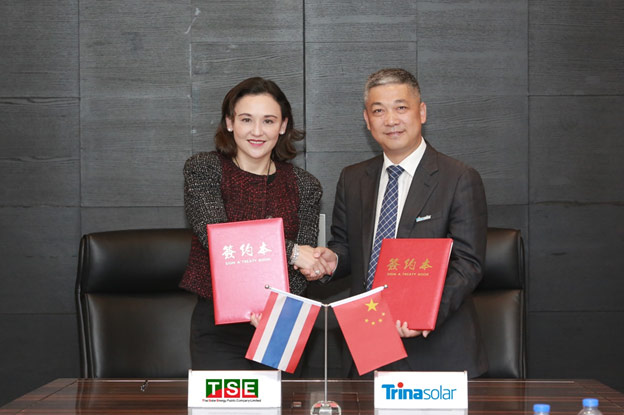SHANGHAI (6 June, 2019) - Trina Solar, the world leading global PV and smart energy total solution provider, signed a memorandum of understanding (MOU) today with Thai Solar Energy for the development of a solar plant in Onikobe, Japan.

(Photo: The memorandum of understanding (MOU) was signed on behalf of Thai Solar Energy by Cathleen Maleenont, CEO and by Yin Rongfang, executive vice president on behalf of Trina Solar)
The MOU also aims to establish a foundation for future cooperation in Southeast Asia between Trina Solar and Thai Solar Energy, one of Thailand’s largest solar developers.
“We consider this MOU as the formal alignment of both our interests. With the size of this project, the use of the latest solar technology and the choice of such a developed market as Japan, both Thai Solar Energy and Trina Solar are showing our ambition in Asia,” says Yin Rongfang, Trina Solar executive vice president.
He and Thai Solar Energy CEO, Dr Cathleen Maleenont, signed the MOU today at the 2019 SNEC PV Power Expo in Shanghai. Trina Solar is one of the major exhibitors at the 2019 SNEC PV Power Expo.
Thai Solar Energy’s utility-scale plant in Onikobe, which is in northeastern Japan’s Miyagi prefecture, is the Thai company’s largest so far. It will use Trina Solar’s new 405W and 410W Tallmax TSM-DE15M(II) modules.
“The Tallmax modules were selected for their industry-leading output and exceptional reliability,” says Yin.
“Our modules will provide a strong return on investment for Thai Solar Energy. The developer has already partnered with us in Thailand on several other projects thanks to our good market reputation and bankability ratings,” he says.
The improvement in Trina Solar’s Tallmax module output from 370W to 415W reduces balance of system (BOS) costs by 4.5-8.5% and levelised costs of electricity (LCOE) by 2.5-4.6%. This is because less construction, equipment, cabling and land are required to achieve the same total power output.
One innovation behind this upgrade is the use of multi-busbar technology, where finer and shorter busbar reduce current resistance whilst allowing more light to be reflected back to the round ribbon. The half-cut cell design further reduces current resistance by about three quarters that of a full cell, resulting in improved efficiency.
